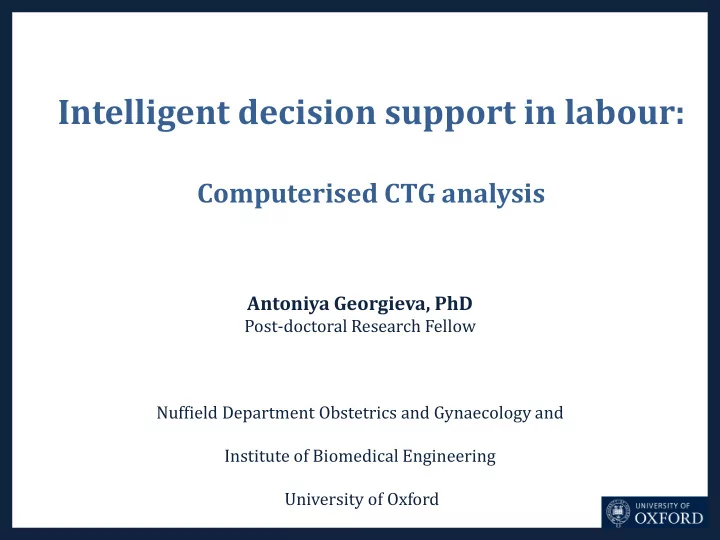

Intelligent decision support in labour: Computerised CTG analysis Antoniya Georgieva, PhD Post-doctoral Research Fellow Nuffield Department Obstetrics and Gynaecology and Institute of Biomedical Engineering University of Oxford
Introduction What is the cardiotocogram (CTG)? Fetal Heart Rate (FHR) and uterus contractions are measured and displayed on paper (Fig. 1(a)). Often Doppler ultrasound is used (Fig. 1(b)). (a) Contractions (TOCO) FHR (Doppler ultrasound) (b) Adapted from www.doctoronline.nhs.uk Figure 1. The CTG produced with a Doppler ultrasound.
Introduction What is the CTG used for? Non-invasive method for monitoring the condition of the fetus during labour. The most common fetal problem is hypoxemia and/or metabolic acidaemia. Failure to intervene when necessary can cause neurological damage and morbidity. Misjudgement can lead to unnecessary caesarean birth.
Introduction What do we do? We are developing a real-time decision support computerised system ( OxSys ). The aims are: Ariana Smalley age 18 months, suffers from birth asphyxia which has resulted in delayed development ,seizure assist diagnosis of birth asphyxia and objectively disorder and needs a feeding tube. estimate the risk for compromise. Craig Rubadoux, www.pictopia.com add to our knowledge of the fetal physiological responses to the stress of labour, not fully understood at present. reduce the number of unnecessary interventions.
Introduction What is the clinical staff looking for in the CTG? A number of studies in the last 40 years have tried to identify the CTG features that are related to asphyxia. Baseline Decelerations Accelerations Variability Contractions Figure 2. CTG in labour and signal features of interest.
Outcome measures APGAR scores: Arterial and venous blood samples http://www.k2ms.com/
Recommend
More recommend